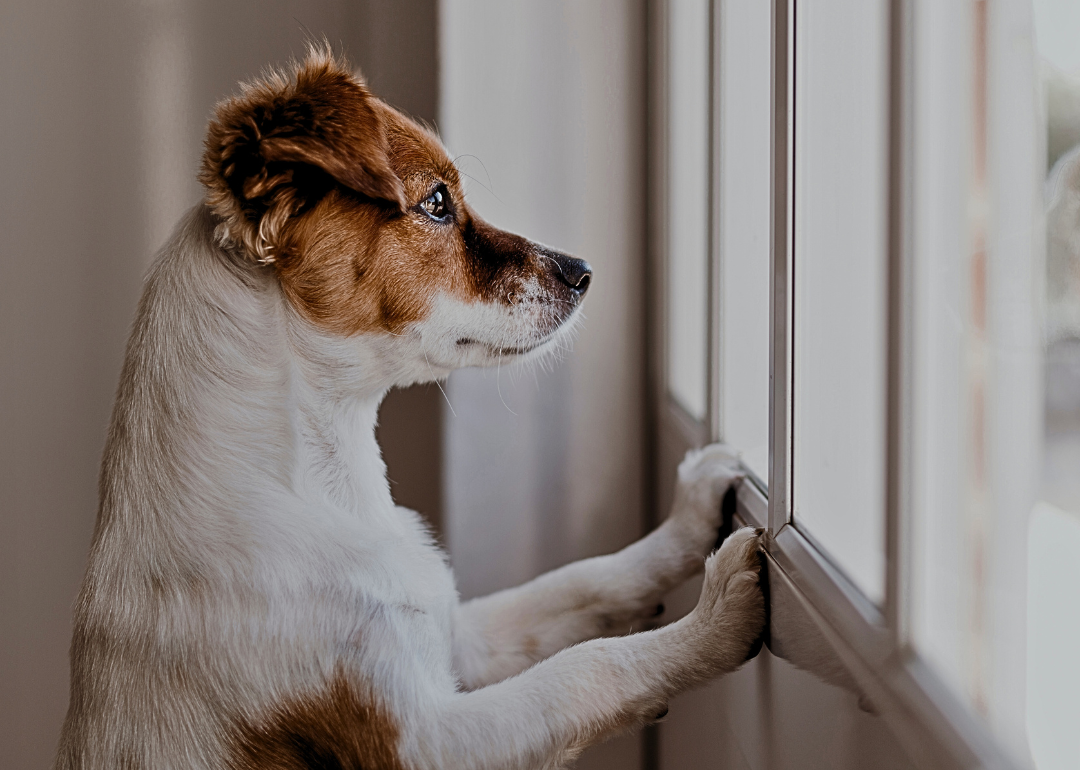
How the pandemic affected separation anxiety in dogs and humans
This story originally appeared on Ollie and was produced and distributed in partnership with Stacker Studio.
How the pandemic affected separation anxiety in dogs and humans
Each day, millions of dogs greet their returning owners with tails wagging as though they've been separated for an eternity. But behind approximately every four or six of those happy faces lie the hallmarks of separation anxiety: chewed-up belongings, scratched doors and windows, and accidents.
As pet owners return to the office following the ease of pandemic-related restrictions, many are now noticing such behavioral problems emerge or worsen. Ollie looked into how the pandemic impacted separation anxiety in dogs and humans, as well as its lasting effects on dog-human relationships, using news reports and research studies.
Between the start of the COVID-19 pandemic in early 2020 and January 2022, over 23 million American households welcomed new canine companions into their families. This means that as owners have been called back into the office in more recent years, many pairings have had to separate for the first time. From an anxious dog's perspective, the disappearance of their owner is more than just heartbreaking: It means they no longer have a reliable source of food, water, or care and, therefore, must fend for themselves or quickly reunite with their owner.
Common symptoms of separation anxiety reflect an inability to cope with the stress of this perceived change (such as self-injury through excessive self-soothing behaviors like paw licking) or desperation to escape it (such as scratching at doors and barking). Specifically, symptoms typically encompass vocalization, destruction, and elimination behaviors.
If the market for pet products is any indication, owners are truly trying to help their furry loved ones with this struggle. In fact, the canine separation anxiety treatment market, in particular, has surged and is expected to continue on that trajectory, exceeding $26.13 million by the end of 2031.
While pet owners typically turn to pet relinquishment as a last resort, this appears to be the case far more often as of late. Dog intake in shelters has increased by 2.5% between January and September 2023, a continuation of a three-year-long trend, according to Shelter Animals Count's Q3 2023 data analysis.
Recognizing and treating anxiety in dogs
For those fortunate enough to remain together, separation anxiety remains an obstacle to overcome. Dogs adopted during the pandemic became accustomed to being alongside their remote-working owners full-time. The shift to remote work was so widespread it was given some special attention in the Bureau of Labor Statistics' 2022 American Time Use Survey. The New York Times reported that Americans spent about two extra hours at home in 2020 versus the year prior. Now, time that used to be spent with pet and owner together is spent alone for many four-legged companions.
This impacted "pandemic puppies," dogs that were born and raised during lockdown restrictions, to an even greater degree. As the American Animal Hospital Association explains, "Animals are best able to learn to respond to social and physical environments during specific neurodevelopmental life stages." Unfortunately, the pandemic severely reduced the environments and situations available for growing dogs to explore during their periods of neurodevelopment, as social interactions for both humans and animals were severely limited.
For example, dogs who are not permitted to explore new environments by 14 weeks of age exhibit "freezing" behavior when faced with the opportunity to explore a different place, meaning they lack the skills or confidence to successfully interact with unfamiliar environments on their own. For many pet owners during the pandemic, there were few or zero opportunities to expose their dogs to both new environments and other dogs. As a result, another trend is occurring among dogs 3 years old and younger: an increase in dog aggression towards other dogs. Of course, learning is lifelong and a dog past its formative years is certainly capable of behavioral change.
The idea of a beloved, adorable companion scared and alone at home is enough to trigger anxiety in any owner. What's more, recent studies demonstrate that bonded dogs and humans can experience what is known as emotional contagion: The way a friend's smile can make us happy or our child's hurts also make us feel hurt, our emotions can be influenced by those around us, including the pets we steward. Without intervention, this shared anxiety can become cyclical and self-perpetuating. However, this also means improvement in a dog's anxiety will naturally ease it in its owner as well.
Products designed to address canine separation anxiety, however, typically only provide temporary relief from its symptoms. Therefore, the underlying cause must still be addressed via proven dog behavioral modification methods: positive reinforcement and reward-based training. In practice, this could mean giving a dog a treat or special toy every time the front door closes so they learn to associate the sound with something that induces excitement rather than fear.
Increasing stress-coping resources in dogs is another way to help them manage alone time. This might include items that soothe (such as a heated stuffed animal) or items that distract (such as a treat puzzle or ball). Extra opportunities for social connection from a playmate, or perhaps another dog, might also be another option—albeit only for the ambitious. After all, due to increased shelter intakes, there are plenty more companions to choose from.
Story editing by Carren Jao. Copy editing by Tim Bruns.



